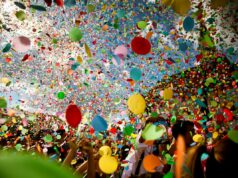
The Essentials
Fasching takes place in Germany in the period between November 11th and Ash Wednesday, which marks the beginning of Lent. More here…
Karneval in Germany falls on different dates each year, as it depends on Easter Sunday, which is determined by movable feasts. Here you can learn more…
Fasching is a colorful carnival season celebrated in Germany, featuring parades, costumes, music, dance, and festivities to drive away winter and mark the beginning of the fasting period. Read more here…
Are you ready for an exciting journey to Fasching in Germany? Prepare to be enchanted by vibrant costumes, joyful parades, and exuberant celebrations. Fasching, also known as Karneval or Fastnacht, is a carnival season celebrated in various regions of Germany. In this blog post, I’ll take you on a whirlwind tour of this spectacular event, highlighting its history, traditions, and must-see highlights. Get ready to immerse yourself in the exhilarating world of carnival!
The Origins of Fasching: A Celebration Through the Ages

Carnival has its roots in ancient pagan traditions that celebrated the end of winter and the arrival of spring. These rituals were an expression of joy as people rejoiced in the longer days, warmer weather, and the promise of new life. These early celebrations often included bonfires, processions, and masquerades.
Advice: Arrive early to secure a good viewing spot along the parade route, as Fasching parades can attract large crowds.
As Christianity spread throughout Europe, these pagan celebrations gradually incorporated Christian elements, most notably the celebration of Carnival. Carnival, derived from the Latin phrase “carne vale” meaning “farewell to meat,” marked the period of feasting and revelry before the beginning of Lent, a period of fasting and penance in the Christian calendar.
In Germany, carnival takes on different names and forms depending on the region. In the Rhineland it is commonly known as Karneval, while in Swabia and Bavaria it is called Fastnacht. Despite these regional variations, the underlying spirit of celebration and joy remains the same.
Today, Fasching is a cherished tradition deeply rooted in German culture. It typically begins at 11:11 a.m. on November 11, known as the “fifth season,” and culminates in the days leading up to Ash Wednesday. The duration of Carnival varies from region to region, with some celebrating for a few days and others extending the festivities over several weeks.
Throughout history, carnival has served as a temporary escape from the constraints of everyday life. It has provided an opportunity for people to let loose, indulge in merriment, and temporarily subvert social norms. This aspect of carnival is most evident in the wearing of masks and costumes, which allow individuals to assume different identities and express themselves freely.
Fasching Traditions: A Window into German Culture

As we continue our exploration of Carnival, let’s take a closer look at the traditions that make this carnival season a fascinating window into German culture.
Fasching masks and costumes: One of the most visually striking aspects of Carnival is the elaborate masks and costumes worn by participants. Masks have a long history in carnival, dating back to ancient pagan rituals. These masks often feature exaggerated facial expressions, mythical creatures, or traditional characters. They allow individuals to temporarily shed their own identity and assume a new persona for the duration of the festivities. Similarly, costumes range from historical figures to fictional characters, from fairy tale creatures to fanciful inventions. The variety and creativity of carnival costumes is truly impressive, with each individual putting their own unique spin on their attire.
Tip: Don’t forget to bring a bag or basket to catch the candies and small gifts thrown during the Fasching parade – it’s a sweet and exciting tradition!
Fasching treats: No celebration is complete without indulging in delicious treats, and carnival is no exception. An iconic treat associated with carnival is the Berliner, a round, jelly-filled doughnut dusted with powdered sugar. These sweet treats are a staple at this time of year and are enjoyed by young and old alike. Another popular treat is the Krapfen, a similar doughnut filled with various sweet fillings such as jam or cream. These delicious treats are often enjoyed with a cup of coffee or hot chocolate, adding an extra layer of coziness to the carnival experience.
Fasching songs and dances: Music and dance play a central role in carnival, creating an atmosphere of joy and celebration. Traditional carnival songs, known as “carnival songs,” are sung during parades and gatherings, accompanied by lively music. These songs often have catchy melodies and lyrics that tell humorous stories or poke fun at social norms. In addition to singing, dancing is also an integral part of carnival. Traditional carnival dances, such as the polonaise or schunkeln, bring people together in synchronized movements, fostering a sense of unity and camaraderie.
Carnival Parades: A Spectacle of Joy

Get ready to be swept away by the vibrant energy and captivating sights of Carnival parades. These grand processions are a highlight of the festival and showcase the creativity, enthusiasm, and community spirit of Mardi Gras revelers.
Colorful floats: Imagine yourself standing on the sidelines, eagerly awaiting the arrival of the Mardi Gras parade. As the procession begins, your eyes widen with delight as you catch sight of the elaborate floats adorned with a riot of colors and decorations. Often themed, these floats are a testament to the artistic ingenuity and craftsmanship of the participants. From fairytale castles to mythical creatures, each float tells a story and adds to the magical atmosphere of Carnival.
Costumed participants: As the floats pass by, you’ll be greeted by a lively cast of characters in stunning costumes. People of all ages, dressed as historical figures, fictional heroes or fanciful creatures, fill the streets with a kaleidoscope of color. The attention to detail in these costumes is remarkable, with intricate designs, vibrant fabrics, and eye-catching accessories. You’ll be captivated by the sheer variety and creativity on display, as each participant brings their unique interpretation to the carnival spirit.
Marching bands and music: The air pulsates with the infectious rhythms of marching bands, adding an irresistible beat to the Mardi Gras parade. These talented musicians, dressed in their own distinctive uniforms, create an exhilarating atmosphere with their lively tunes. The music fills the streets, inviting spectators to tap their feet, clap their hands and join in the joyous celebration. Marching bands add a dynamic element to the parade, giving it a sense of excitement and rhythm.
Dance Troupes: Along with the floats and marching bands, you’ll see captivating dance troupes twirl, leap and bring the streets to life with their choreographed routines. These skilled dancers, adorned in dazzling costumes, perform synchronized movements with precision and grace. Whether it’s traditional folk dances or contemporary performances, their energy and talent is mesmerizing. Dance troupes add an extra layer of dynamism and artistry to the carnival parade, captivating audiences with their skillful performances.
Additional Information: The largest and most famous Fasching parade in Germany takes place in Cologne, attracting hundreds of thousands of spectators each year.
Candy Showers: Get ready for an extra sprinkling of joy during the Mardi Gras parade – the candy showers! A beloved tradition, floats and marching bands toss candy, small gifts and sometimes even flowers into the crowd. Children and adults alike eagerly reach out to catch these sweet treats, adding an element of excitement and surprise to the festivities. It’s a joyous moment that brings smiles to faces and creates an interactive bond between participants and spectators.
Embracing the Magic of Fasching in Germany
Congratulations! You’ve just experienced a whirlwind tour of Fasching, Germany’s dazzling carnival season. From its ancient origins to its modern celebrations, Carnival is an unforgettable experience that brings communities together in joyful celebration. Whether you’re a participant in an elaborate costume or an enthusiastic spectator, Mardi Gras will leave you with memories to cherish. So get ready to unleash your inner party animal and immerse yourself in the magic of Mardi Gras. Let the festivities begin!

















